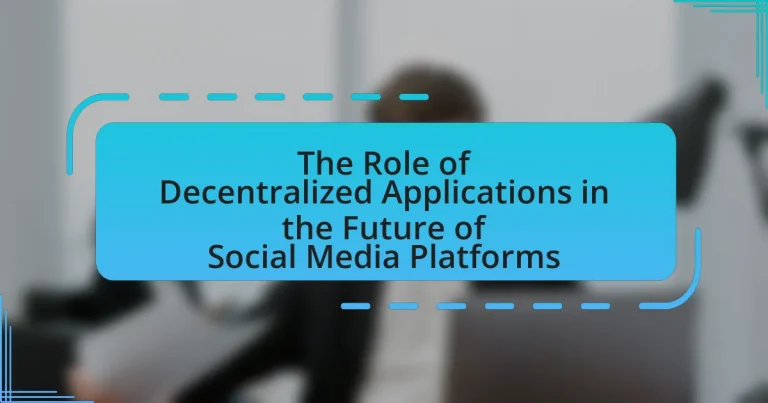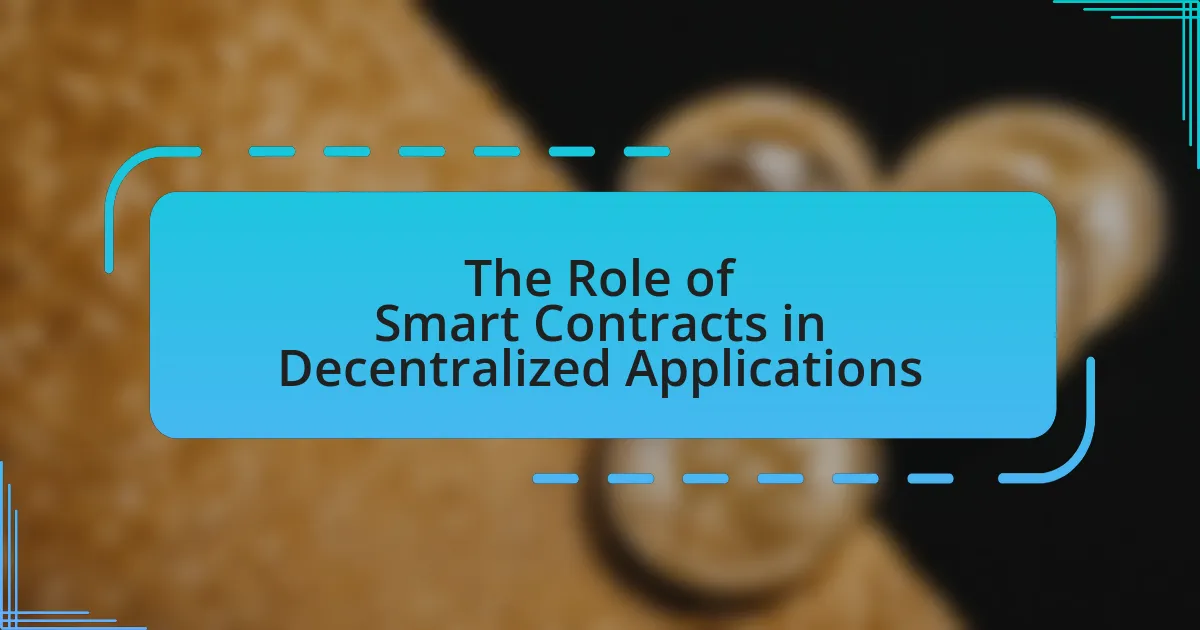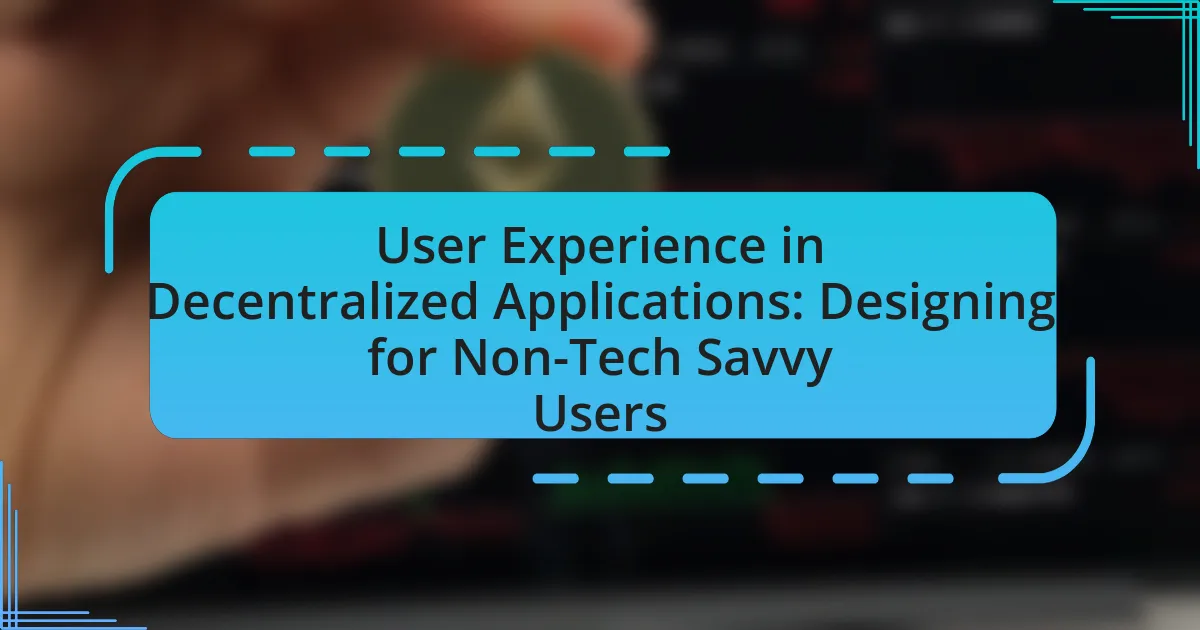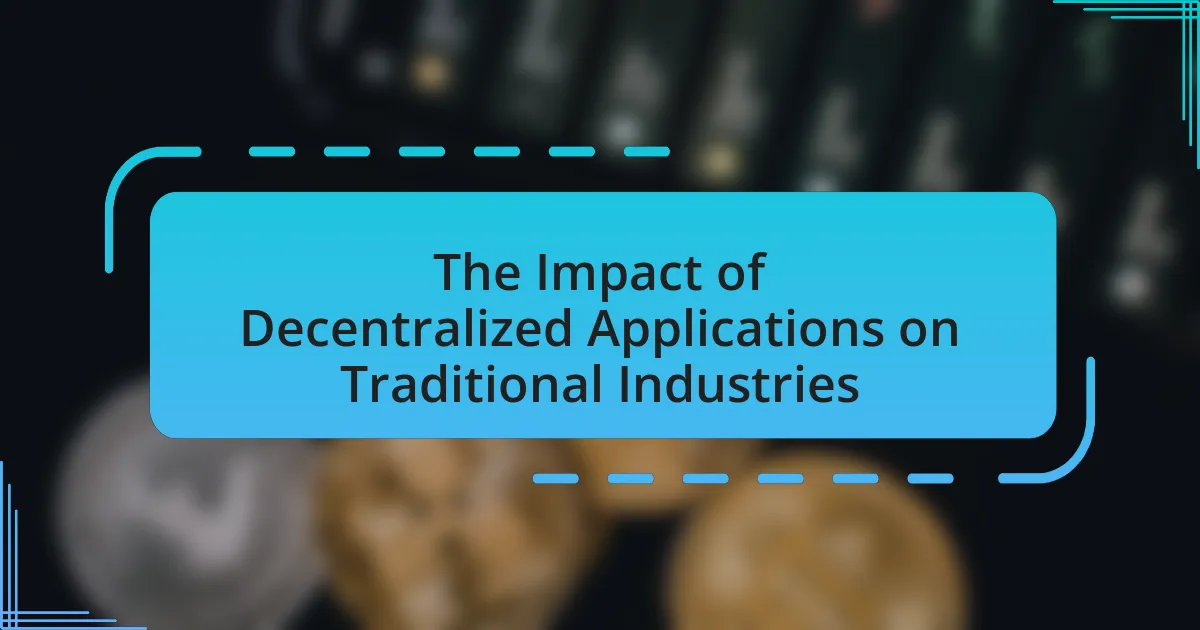Decentralized applications (dApps) are software programs that operate on blockchain or peer-to-peer networks, offering significant advantages in the realm of social media. This article explores the importance of dApps in enhancing user privacy, data ownership, and resistance to censorship, contrasting them with traditional centralized platforms. Key topics include the technologies that underpin dApps, their potential benefits for users, the economic advantages for content creators, and the challenges they face, such as scalability and regulatory compliance. Additionally, the article discusses future trends and innovations in decentralized social media, emphasizing the growing demand for user-centric digital experiences.
What are Decentralized Applications and Their Importance in Social Media?
Decentralized applications (dApps) are software applications that run on a blockchain or peer-to-peer network, rather than being hosted on centralized servers. Their importance in social media lies in their ability to enhance user privacy, data ownership, and censorship resistance. Unlike traditional social media platforms, which often control user data and content, dApps empower users by allowing them to maintain control over their information and interactions. For instance, platforms like Mastodon and Diaspora utilize decentralized architecture to provide users with greater autonomy and security, reducing the risk of data breaches and manipulation. This shift towards decentralization is crucial as it addresses growing concerns about privacy and the monopolistic tendencies of major social media companies.
How do decentralized applications differ from traditional social media platforms?
Decentralized applications (dApps) differ from traditional social media platforms primarily in their governance and data control. dApps operate on blockchain technology, allowing users to maintain ownership of their data and participate in decision-making processes, whereas traditional social media platforms are centralized, meaning a single entity controls user data and platform policies. This fundamental difference promotes user privacy and reduces censorship, as evidenced by platforms like Mastodon, which allows users to create their own servers and control their content, contrasting with Facebook’s centralized data management and content moderation policies.
What technologies underpin decentralized applications?
Decentralized applications (dApps) are primarily underpinned by blockchain technology, smart contracts, and peer-to-peer networking. Blockchain serves as the foundational technology that ensures data integrity and transparency through a distributed ledger system. Smart contracts, which are self-executing contracts with the terms of the agreement directly written into code, automate processes and enforce rules without intermediaries. Peer-to-peer networking facilitates direct interactions between users, enhancing decentralization by removing central authorities. These technologies collectively enable dApps to operate in a secure, transparent, and efficient manner, making them suitable for various applications, including social media platforms.
How do decentralized applications enhance user privacy and security?
Decentralized applications enhance user privacy and security by eliminating centralized control over user data. In these applications, data is stored across a distributed network rather than on a single server, reducing the risk of data breaches and unauthorized access. For instance, blockchain technology, commonly used in decentralized applications, employs cryptographic techniques to secure user information, ensuring that only users have access to their private keys. This architecture inherently limits the ability of third parties to track or manipulate user data, thereby fostering a more private and secure environment for users.
Why is decentralization a critical trend in social media?
Decentralization is a critical trend in social media because it empowers users by giving them control over their data and interactions. This shift addresses growing concerns about privacy, censorship, and the monopolistic practices of centralized platforms. For instance, a study by the Pew Research Center found that 79% of Americans are concerned about how companies use their data, highlighting the demand for alternatives that prioritize user autonomy. Decentralized applications (dApps) facilitate this by enabling peer-to-peer interactions without intermediaries, thus fostering a more equitable digital environment.
What are the limitations of centralized social media platforms?
Centralized social media platforms face significant limitations, including lack of user control, data privacy concerns, and susceptibility to censorship. Users have limited control over their data, as these platforms often own and monetize user-generated content without adequate compensation. Data privacy is compromised, with incidents like the Cambridge Analytica scandal highlighting how user information can be exploited. Furthermore, centralized platforms can censor content based on their policies, which raises concerns about freedom of expression. These limitations underscore the need for decentralized alternatives that empower users and enhance privacy.
How does decentralization empower users and content creators?
Decentralization empowers users and content creators by providing them with greater control over their data and content distribution. In decentralized systems, users retain ownership of their information, reducing reliance on centralized platforms that often exploit user data for profit. This shift allows content creators to monetize their work directly, bypassing intermediaries that typically take a significant cut of earnings. For example, blockchain technology enables creators to receive payments in cryptocurrency, ensuring they receive a fair share of revenue without high transaction fees. Additionally, decentralized applications foster community governance, allowing users to participate in decision-making processes, which enhances transparency and accountability.
What are the Potential Benefits of Decentralized Applications for Social Media Users?
Decentralized applications (dApps) offer several potential benefits for social media users, including enhanced privacy, greater control over personal data, and reduced censorship. Users can maintain ownership of their data, as dApps typically operate on blockchain technology, which allows for secure and transparent data management. This ownership means users can decide how their information is shared and monetized, unlike traditional platforms that often exploit user data for profit. Additionally, dApps can provide a more democratic environment by minimizing the influence of centralized authorities, thereby reducing the risk of censorship and promoting free speech. Studies have shown that users are increasingly concerned about data privacy, with a Pew Research Center survey indicating that 79% of Americans are worried about how their data is being used by companies.
How can decentralized applications improve user engagement?
Decentralized applications can improve user engagement by enabling greater user control and ownership over data and content. This increased autonomy fosters a sense of community and trust among users, as they can directly participate in governance and decision-making processes. For instance, platforms like Steemit reward users for content creation and curation, leading to higher participation rates. Additionally, decentralized applications often incorporate token-based incentives, which can enhance user motivation to engage with the platform. Research indicates that user engagement increases when individuals feel a sense of ownership and are rewarded for their contributions, as seen in various blockchain-based social media platforms.
What features do decentralized applications offer that enhance user experience?
Decentralized applications (dApps) enhance user experience through features such as increased privacy, enhanced security, and greater control over personal data. These applications operate on blockchain technology, which ensures that user data is not stored on a central server, thereby reducing the risk of data breaches and unauthorized access. For instance, a study by the World Economic Forum highlights that blockchain can provide users with ownership of their data, allowing them to decide how and with whom to share it. Additionally, dApps often utilize smart contracts, which automate processes and reduce the need for intermediaries, leading to faster transactions and lower fees. This combination of privacy, security, and user control significantly improves the overall experience for users engaging with social media platforms.
How do decentralized applications facilitate community building?
Decentralized applications facilitate community building by enabling direct peer-to-peer interactions without intermediaries. This structure fosters trust and transparency among users, as all transactions and communications are recorded on a blockchain, ensuring accountability. For instance, platforms like Ethereum allow developers to create decentralized social networks where users can share content and collaborate directly, enhancing engagement and participation. Additionally, decentralized governance models empower community members to have a say in platform decisions, further strengthening community ties. Research indicates that decentralized platforms can lead to increased user retention and satisfaction due to their inclusive nature and user-centric design.
What economic advantages do decentralized applications provide?
Decentralized applications (dApps) provide significant economic advantages by reducing operational costs and enhancing user monetization opportunities. By eliminating intermediaries, dApps lower transaction fees and operational overhead, allowing for more efficient resource allocation. For instance, a study by the World Economic Forum highlights that blockchain technology, which underpins many dApps, can reduce costs in various sectors by up to 30% through increased efficiency and transparency. Additionally, dApps empower users to directly monetize their contributions, such as content creation, through tokenization and decentralized finance mechanisms, fostering a more equitable economic model. This shift not only incentivizes user engagement but also redistributes value back to the community, contrasting with traditional platforms that often centralize profits.
How do decentralized applications enable new monetization models for creators?
Decentralized applications (dApps) enable new monetization models for creators by facilitating direct transactions between creators and their audiences without intermediaries. This direct interaction allows creators to retain a larger share of their earnings, as they are not subject to platform fees typically charged by centralized services. For instance, platforms like Ethereum enable creators to use smart contracts, which automate payment processes and ensure transparency in revenue distribution. Additionally, dApps often incorporate token economies, allowing creators to issue their own tokens that can be used for access to exclusive content or services, further diversifying their income streams. This shift not only empowers creators financially but also fosters community engagement, as audiences can support creators directly through contributions or purchases.
What role do cryptocurrencies play in decentralized social media platforms?
Cryptocurrencies serve as a fundamental economic incentive in decentralized social media platforms, enabling users to earn rewards for content creation, curation, and engagement. This model fosters a user-driven ecosystem where participants are compensated directly for their contributions, enhancing user participation and content quality. For instance, platforms like Steemit utilize a cryptocurrency-based reward system that allows users to earn tokens for posting and curating content, thereby aligning financial incentives with user engagement. This approach not only empowers users but also reduces reliance on traditional advertising models, which can compromise user privacy and data ownership.
What Challenges Do Decentralized Applications Face in Social Media?
Decentralized applications in social media face significant challenges, including scalability, user adoption, and regulatory compliance. Scalability issues arise because decentralized networks often struggle to handle large volumes of users and data, leading to slower performance compared to centralized platforms. User adoption is hindered by the complexity of decentralized systems, which can deter non-technical users from engaging with these platforms. Additionally, regulatory compliance poses a challenge as decentralized applications must navigate varying legal frameworks across different jurisdictions, which can complicate operations and limit growth. These challenges collectively impact the effectiveness and viability of decentralized applications in the social media landscape.
What are the technical hurdles in developing decentralized social media applications?
Developing decentralized social media applications faces several technical hurdles, including scalability, data privacy, and user experience. Scalability issues arise because decentralized networks often struggle to handle large volumes of users and data efficiently, as seen in blockchain-based platforms where transaction speeds can be slow. Data privacy concerns are heightened in decentralized systems, as users may have difficulty controlling their personal information across multiple nodes, leading to potential data leaks. Additionally, ensuring a seamless user experience is challenging due to the complexity of decentralized technologies, which can deter mainstream adoption. These hurdles collectively hinder the widespread implementation and functionality of decentralized social media applications.
How do scalability issues affect decentralized applications?
Scalability issues significantly hinder the performance and user experience of decentralized applications (dApps). When a dApp cannot efficiently handle an increasing number of users or transactions, it leads to slower processing times and higher transaction costs, which can deter user adoption. For instance, Ethereum, a leading platform for dApps, has faced congestion during peak usage, resulting in transaction fees surging to over $50 in 2021. This demonstrates that scalability challenges can directly impact the usability and accessibility of decentralized applications, limiting their effectiveness in social media platforms and other sectors.
What security concerns arise with decentralized social media platforms?
Decentralized social media platforms face significant security concerns, primarily due to their lack of centralized control. This decentralization can lead to challenges in content moderation, making it easier for harmful content, such as hate speech or misinformation, to proliferate without effective oversight. Additionally, the absence of a central authority complicates user data protection, increasing the risk of data breaches and unauthorized access to personal information. Research indicates that decentralized systems can also be more vulnerable to coordinated attacks, such as Distributed Denial of Service (DDoS) attacks, which can disrupt platform functionality. Furthermore, the reliance on blockchain technology, while enhancing transparency, can expose users to risks associated with smart contract vulnerabilities, potentially leading to financial losses or exploitation.
How can user adoption be encouraged for decentralized applications?
User adoption for decentralized applications can be encouraged through user-friendly interfaces and robust educational resources. Simplifying the onboarding process and providing clear instructions can help users navigate these applications more easily. Additionally, offering incentives such as token rewards or exclusive features for early adopters can motivate users to engage with decentralized platforms. Research indicates that platforms with strong community support and active user engagement strategies see higher adoption rates, as evidenced by the success of projects like Ethereum and its developer community.
What strategies can be employed to educate users about decentralized platforms?
To educate users about decentralized platforms, comprehensive educational programs should be implemented. These programs can include interactive workshops, online courses, and webinars that explain the principles of decentralization, blockchain technology, and the benefits of using decentralized applications. For instance, organizations like the Blockchain Education Network provide resources and training to enhance understanding of these concepts. Additionally, creating user-friendly guides and tutorials can facilitate easier navigation of decentralized platforms, helping users grasp their functionalities and advantages. Engaging content, such as videos and infographics, can also be effective in conveying complex information in an accessible manner.
How can decentralized applications build trust among users?
Decentralized applications can build trust among users by ensuring transparency and security through blockchain technology. This technology allows users to verify transactions and interactions independently, reducing reliance on a central authority. For instance, smart contracts automatically execute agreements when conditions are met, minimizing the risk of fraud. Additionally, decentralized applications often utilize open-source code, enabling users to audit and verify the software for vulnerabilities, which further enhances trust. According to a report by the World Economic Forum, 10% of global GDP could be stored on blockchain by 2027, indicating a growing reliance on decentralized systems for secure transactions.
What are the future trends for decentralized applications in social media?
Future trends for decentralized applications in social media include increased user control over data, enhanced privacy features, and the rise of community-driven governance models. These applications are expected to empower users by allowing them to own their content and personal information, reducing reliance on centralized platforms. For instance, projects like Mastodon and Diaspora demonstrate how decentralized networks can facilitate user autonomy and foster niche communities. Additionally, the integration of blockchain technology is likely to enhance transparency and security, as seen in platforms like Steemit, which rewards users for content creation. As regulatory scrutiny on data privacy intensifies, decentralized applications will likely gain traction as alternatives to traditional social media, aligning with the growing demand for user-centric digital experiences.
How might regulatory changes impact decentralized social media platforms?
Regulatory changes could significantly impact decentralized social media platforms by imposing compliance requirements that challenge their foundational principles of user autonomy and data privacy. For instance, regulations like the General Data Protection Regulation (GDPR) in Europe mandate strict data handling and user consent protocols, which may conflict with the decentralized model that prioritizes user control over data. Additionally, regulatory scrutiny could lead to increased operational costs for these platforms as they adapt to legal frameworks, potentially stifling innovation and user engagement. Historical examples, such as the impact of the Digital Millennium Copyright Act (DMCA) on online platforms, illustrate how regulatory measures can reshape the operational landscape, often leading to more centralized control despite the original intent of decentralization.
What innovations are on the horizon for decentralized applications?
Innovations on the horizon for decentralized applications include enhanced interoperability, improved scalability, and advanced privacy features. Enhanced interoperability will allow different decentralized applications to communicate seamlessly, fostering a more integrated ecosystem. Improved scalability solutions, such as layer-2 protocols, aim to increase transaction throughput and reduce latency, addressing current limitations in user experience. Advanced privacy features, including zero-knowledge proofs, will enable users to maintain control over their data while interacting with decentralized platforms. These innovations are driven by ongoing research and development in blockchain technology, aiming to create more user-friendly and efficient decentralized applications for social media platforms.
What practical steps can users take to engage with decentralized social media platforms?
Users can engage with decentralized social media platforms by creating an account on a specific platform, such as Mastodon or Diaspora. After selecting a platform, users should familiarize themselves with its unique features and community guidelines. Participating in discussions, sharing content, and connecting with other users are essential steps to enhance engagement. Additionally, users can contribute to the platform’s development by providing feedback or participating in governance if the platform supports decentralized decision-making. Engaging with decentralized social media fosters a sense of community and supports the growth of alternative social networks.





